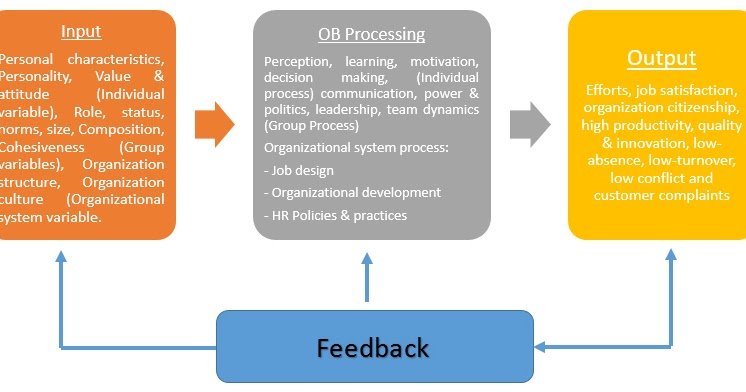Organizational behavior and leadership are two interconnected concepts that play a critical role in the success of any organization. Organizational behavior refers to the study of how people interact within groups in an organization, while leadership is the ability to inspire and guide others towards achieving common goals. This article will explore the relationship between organizational behavior and leadership, how they impact organizational performance, and the key theories and models that underpin their concepts.

Relationship between Organizational Behavior and Leadership:
Organizational behavior and leadership are interrelated because the behavior of employees in an organization is influenced by the leadership style of their leaders. Leadership is a critical element in determining the culture of an organization, and the culture of an organization is the primary driver of behavior. For example, if an organization has a hierarchical leadership structure, employees are likely to be more formal and structured in their behavior. In contrast, if an organization has a more democratic leadership structure, employees are more likely to be creative and innovative in their behavior.
Leadership and organizational behavior can also impact employee motivation, job satisfaction, and productivity. Leaders who demonstrate effective leadership skills such as communication, delegation, and decision-making can inspire employees to work harder, achieve goals, and be more satisfied with their jobs. Similarly, leaders who are autocratic and fail to provide clear communication and direction can create a negative work environment that can lead to low motivation and productivity.
Impact of Organizational Behavior and Leadership on Organizational Performance:
The impact of organizational behavior and leadership on organizational performance is significant. Organizations that have a positive culture, effective leadership, and engaged employees are more likely to achieve their goals and succeed in the long term. Studies have shown that companies with a positive organizational culture have a lower turnover rate, higher employee engagement, and increased profitability. This is because employees are more motivated and committed to the success of the organization, which translates into increased productivity and better customer service.

Pay Someone to Do My Homework for Me
Effective leadership is also crucial for the success of an organization. Leaders who are able to inspire and guide their employees towards achieving common goals are more likely to succeed in achieving their objectives. Effective leaders are also able to communicate effectively with their employees, provide feedback, and delegate tasks appropriately. These leadership skills help to create a positive work environment that fosters collaboration and teamwork, which is essential for organizational success.
Key Theories and Models of Organizational Behavior and Leadership:
There are several key theories and models that underpin the concepts of organizational behavior and leadership. These include:
- Transformational Leadership Theory:
The transformational leadership theory suggests that leaders who inspire and motivate their employees to work towards a shared vision can transform their organizations. Transformational leaders are charismatic, visionary, and inspire their followers to achieve higher levels of performance. This theory emphasizes the importance of leadership in creating a positive organizational culture that fosters creativity, innovation, and teamwork.
- Situational Leadership Theory:
The situational leadership theory proposes that leadership is not a one-size-fits-all approach, but rather, leaders need to adjust their leadership style based on the situation. The theory suggests that leaders should adopt different leadership styles depending on the maturity level of their employees. For example, leaders should adopt a more directive style when working with inexperienced employees and a more delegative style when working with experienced employees.
- Contingency Theory:
The contingency theory suggests that the effectiveness of leadership is dependent on the situation. The theory proposes that there is no one best way to lead, but rather, leaders need to adapt their leadership style to the situation. For example, in a crisis situation, leaders may need to adopt a more directive leadership style, while in a situation where employees are experienced and highly skilled, leaders may need to adopt a more delegative style.
- Social Learning Theory:
The social learning theory suggests that behavior is learned through observation, modeling, and reinforcement. This theory proposes that individuals learn from their environment, including the behavior of others, and can modify their behavior based on the consequences of that behavior. In an organizational setting, this theory can be applied to understand how employees learn new skills, behaviors, and attitudes.
- Organizational Culture Theory:
The organizational culture theory suggests that organizational behavior is shaped by the values, beliefs, and attitudes of the organization. This theory emphasizes the importance of creating a positive organizational culture that aligns with the goals and objectives of the organization. Organizational culture can impact employee motivation, job satisfaction, and productivity, and is often a key factor in determining the success or failure of an organization.
- Transactional Leadership Theory:
The transactional leadership theory proposes that leaders use rewards and punishments to motivate employees to achieve goals. This theory suggests that leaders should focus on setting goals, providing feedback, and rewarding employees for achieving those goals. This leadership style is often used in situations where employees are motivated by external rewards, such as bonuses, promotions, or recognition.
Conclusion:
Organizational behavior and leadership are critical components of organizational success. The relationship between these two concepts is interdependent, and effective leadership can shape the behavior and culture of an organization. Organizational behavior and leadership impact employee motivation, job satisfaction, and productivity, and can significantly impact organizational performance. Understanding the key theories and models of organizational behavior and leadership can help leaders to develop effective leadership styles and create a positive organizational culture that fosters collaboration, innovation, and success.
Find online help in writing essays, research papers, term papers, reports, movie reviews, annotated bibliographies, speeches/presentations, projects, presentations, dissertation services, theses, research proposals, essay editing, proofreading, Book reviews, article reviews, formatting, personal statements, admission essays, scholarship essays, application papers, among others.


 WRITE MY ESSAY NOW!
WRITE MY ESSAY NOW!